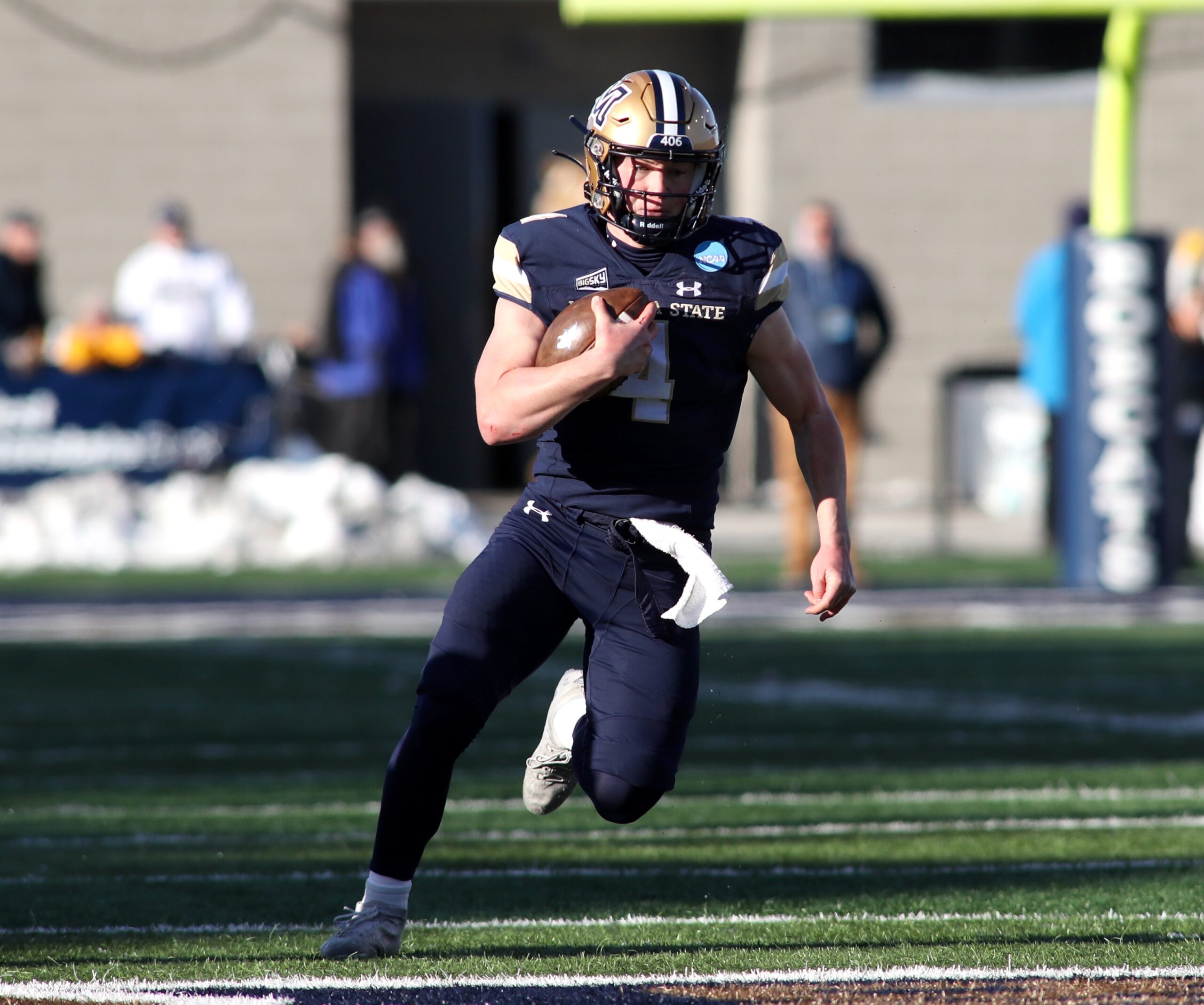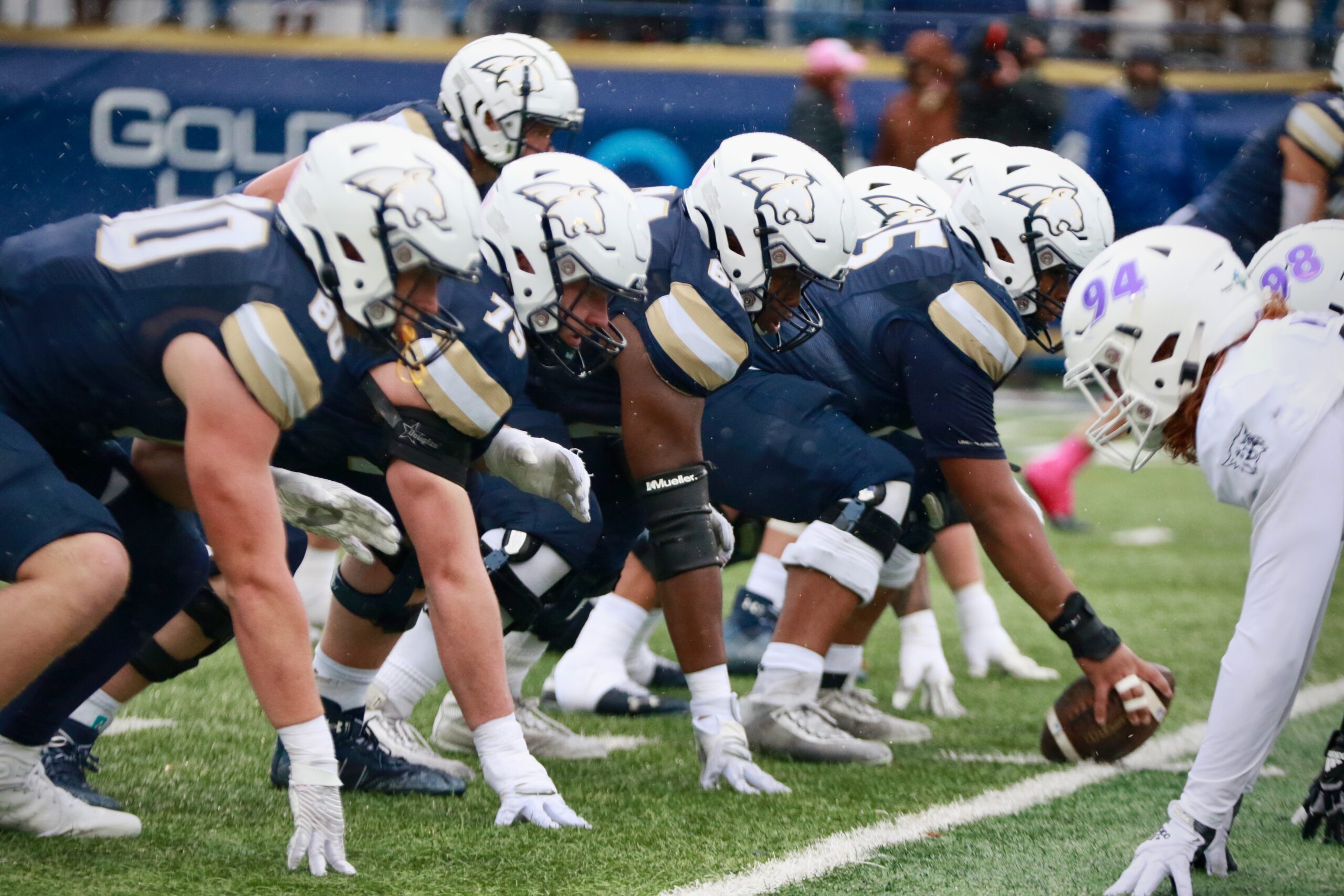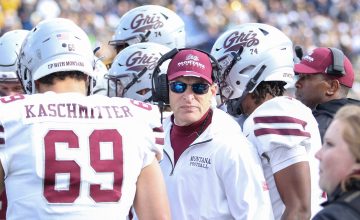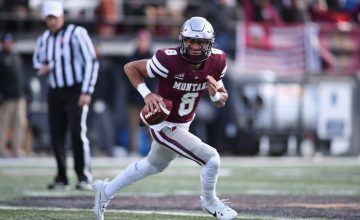The Montana State offensive line is good, that’s plain to see. Figuring out just how good it is, is little more difficult to wrap your head around.
In 2021, the Bobcats graduated three of its starting linemen, including future NFL player Lewis Kidd, off a team that played in the national title game. Another player, TJ Session, transferred and Isaiah Ifanse, a running back who would become the school’s all-time rushing leader would miss the entire regular season recovering from an injury.
The 2021 line led the way to what was then the third-best rushing total in school history with 3,313 yards. The 2022 line returned only center Justus Perkins, but the MSU’ run game would go on to obliterate 2021’s rushing total with 4,336, a school record.
The 2022 line had no seniors and suffered several injuries, including starting guard Cole Sain missing time in the middle of the schedule and starting right tackle Marcus Wehr suffering a season-ending injury midway through last season. Jacob Kettels stepped in for Wehr and the Bobcats continued to mow over opposing defenses until it hit a wall in Brookings, South Dakota, losing to eventual national champion South Dakota State as it ground game was stuffed.
Despite the promise of returning its line intact in 2023, but without the services of Ifanse who transferred to Cal, the Bobcats found themselves missing guards JT Reed and Cole Sain. They would move All-American left tackle Rush Reimer to the left guard spot and inserted guard Omar Aigbedion into the right guard spot. Moore, a freshman, took over Reimer’s tackle position and Wehr returned from injury to step in at the other tackle. The one constant, Perkins, cruised back in at center.

“It would be great to have Cole and JT in the mix,” MSU head coach Brent Vigen said. “It didn’t play out that way so far. We’ve been able to go with the same five guys. I know we got some guys certainly waiting in the wings. When you come out of spring ball feeling like we did about that depth – we return seven guys that started and we added Connor Moore to that mix. When you leave spring ball with eight guys, you feel the chances of throwing out five on a weekly basis are pretty good.”
The players are well aware of the changes and what goes into making the transition a smooth one.
“(Moore) took it on full-heartedly, he’s looking great out there,” Perkins said. “You could tell he had that build already, super athletic as well. He was around us and picked up the offense. l saw the type of worker (Aigbedion) is and he wanted to be the best. He’s always listening and he’s not afraid of constructive criticism.”
Regardless of the personnel turnover and a transition under new offensive line coach Al Johnson, MSU’s run game is not only matching 2022’s prolific pace but is exceeding it not just on a yearly, but also a weekly basis. The Bobcats are well past last year’s amazing 6.5 average yards per carry with an unheard of 7.9 through six games.
“The yards per carry right now, that’s something I’ve never been a part of,” Vigen said. “There’s a couple factors. I know we’ve had a bunch of big plays and in particular with (quarterback) Sean (Chambers) lately, but it seems like every one of the running backs have certainly lent their hand there. In a bunch of our games our twos have come in and really held up their end of the bargain. Adam Jones ripping off that 49-yard run (vs. Cal Poly). We still had a bunch of our starters in there, but that’s what you want to see your next group of guys do. Even at the end Garrett Coon had a long run, Jordan Reed had a long run.

“Our scheme is challenging but moreover our players are talented and they’re really doing their very best. That load has been, with the exception of the South Dakota State game, really spread out. We’ve been able to have fresh ball carriers. Guys have been really trying to seize their opportunities. I’d be remiss if I didn’t say our five guys up front are really playing well. You throw our two tight ends in the mix and that is definitely where all this starts, this production.”
The Bobcats’ run game is multi-faceted. Keying on one thing gets players out of position and creates mismatches.
“But by and large our run game is challenging. Then you throw a sideline to sideline RPO game that we’ve probably done more than anything to this point and our tight ends have been the beneficiaries of those passes that are really an extension of the run game. I don’t think we let defenders get where they want to be. Sean’s long run was a matter of getting too many guys in the box. You think the best way to stop the run is to put all these guys in the box, well you rip off a run like that you gotta do something else, I suppose.”
“I think we have a run game that you have to defend sideline to sideline,” Vigen said. “Typically, that’s not always the case (for most teams). The run exists between the tackles, maybe you get some things off the edge to a tight end side.
Sacramento State head coach Andy Thompson knows much of Saturday night’s action will be dictated in the trenches.
“They have a lot of different schemes and they make you go sideline to sideline and they can run right at ya,” Thompson said. “Then they have a whole bunch of guys when they carry the ball that can break tackles. That combination of the scheme and being able to go inside or outside with the talent with the speed, with receivers and tight ends that block, and the fact that they don’t really care who has the ball, it’s been very, very impressive to watch. It’s going to be a huge challenge for our defense.”
Knowing about the graduation, transfers and injuries over the past three years, it doesn’t seem possible, but the Bobcats don’t seem to think too much about those kinds of details.
The backups, if you include Sain and Reed, are among the best offensive linemen in the Big Sky Conference. The current backups include Kettels and Titan Fleischmann, a pair of highly touted tackles coming out of high school who have given fans whiffs of their abilities over the past year, although Fleischmann continues working his way back from a knee injury. Holden Sampson is a veteran that hasn’t been forced into action due to Perkins’ durability. Yet, he is among a group that performs more than admirably when games are all but put away late.
Kettels, Fleischmann and Sampson, along with Tommy Nilson and Jaden Perkins have seen steady action late in games and the rushing numbers in the fourth quarters of the last four games are astounding. With that group taking a majority of the snaps, MSU has run for 392 yards on just 39 carries. Granted, the opposition also has its backups in a good portion of that time as well but there’s no denying that the second group is able to function at a high level.
Johnson, a former standout at Wisconsin who played for the Dallas Cowboys, has expanded upon the role of the line and that has complimented the run game even further. To go along with the explosive run game, the Bobcats have made strides in the pass game and have allowed a league-low five sacks through six games.
“When you’re teaching a room that’s got 15-plus guys, they all need to feel connected and I think (Johnson) has done a really good job of that,” Vigen said. “We were a work in progress last year and we made tons of progress. We weren’t necessarily great in the pass blocking area and I think Al’s brought a lot there and that’s just building off what Brian (Armstrong) had done previously. We’ve been really pleased with Al, and I think he’s really meshed well with the guys.”

“I think we’ve been improving our pass game,” Wehr said. “Our sets and picking up blitzes. When we do need to pass, we needed to improve that protection. I think (Johnson) fits our system very well. Coming here was a really good fit.”
Johnson came to MSU from the University of Wisconsin – a traditionally run-heavy program – and has made numerous stops and coached several different areas.
“It was evident in the hiring process that Al could really articulate in short order to those guys. That became real apparent to those guys really quickly. Al’s very experienced as a high level player and coaching at all levels and ultimately he was a head coach as well, he was a play caller, so just all-encompassing vision and moreover just his ability to in the moment communicate with five guys at a time.”
MSU’s yards per carry number has grown over each of the past four games. It was 6.2 following a 20-16 loss to SDSU, then 6.8, 7.3, 7.6 and now 7.9 over the successive weeks.
“Really good job by our offensive staff week to week,” Vigen said. “Maybe changing the picture, what it looks like and our guys going out there and really executing. I’d be remiss if I didn’t mention those five guys really playing well up front.”
The Bobcats enter the meat of their schedule this Saturday night when they travel to northern California to take on the third-ranked Sacramento State Hornets. The Bobcats and Hornets tied for the Big Sky Conference title last season, while the Hornets have won at least a share of the last three league championships.
The Hornets upset the PAC-12’s Stanford Cardinal, which is where their head coach from a year ago, Troy Taylor, is now the head coach. Since then however, they’ve lost to Idaho and struggled to get past Northern Arizona and Northern Colorado. The two teams haven’t met since 2019 when the Hornets won the last game by a visiting team in Bobcat Stadium, 34-21.
MSU has had many iterations of its offensive front since the last time the two teams played. Thompson remains impressed with Montana State’s offensive line.
“Their front five on offense is really good, really physical,” Thompson said. “You don’t have the rushing numbers without a great offensive line and those rushing numbers are about as good as you will find. They are No. 1 in the country….they do a great job with everything and are executing at a really high level. It will be a great challenge.”















